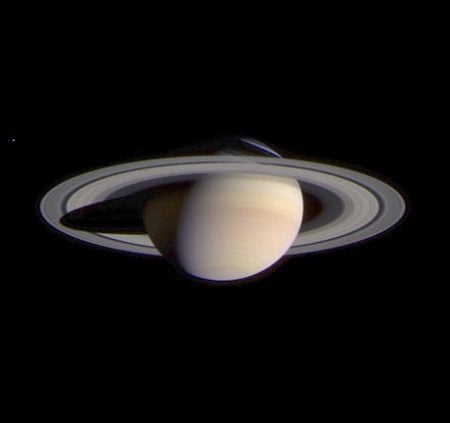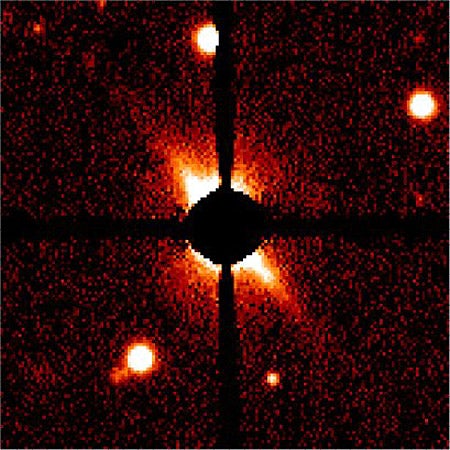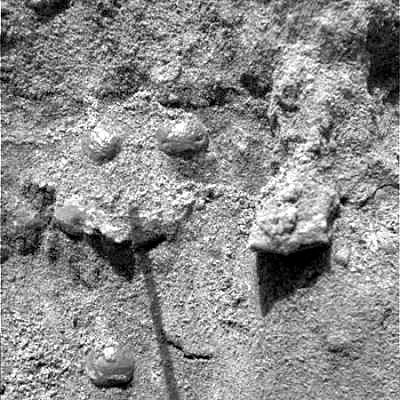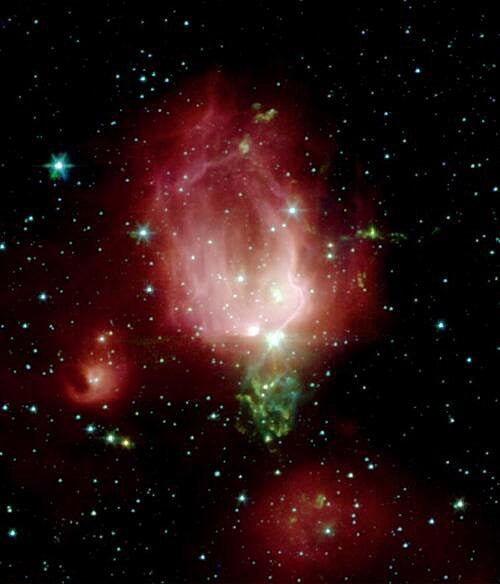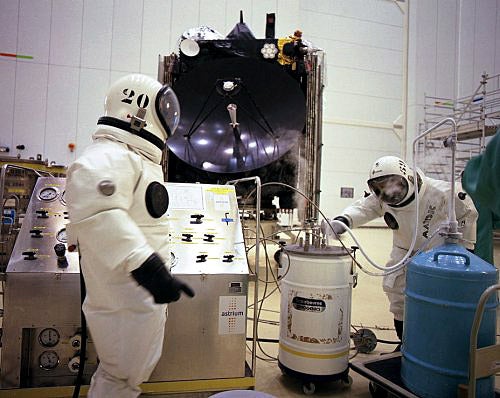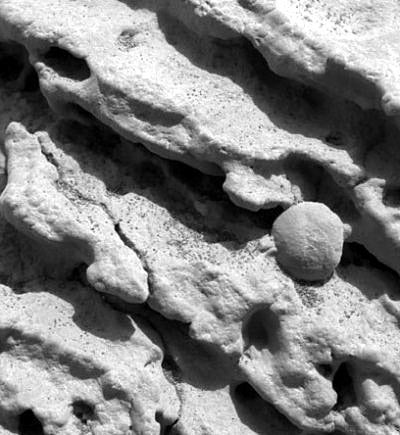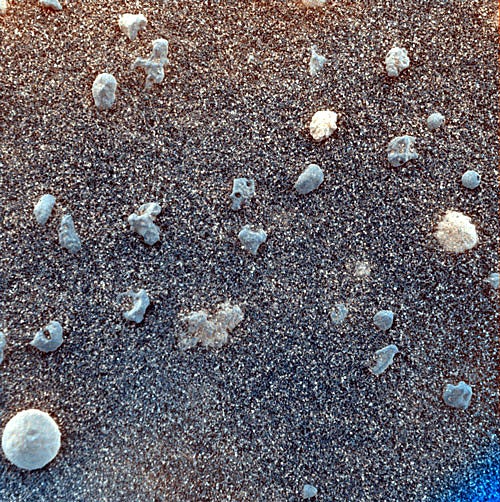Wish you were here
The Cassini imaging team has released the first of what they expect will be weekly color “postcards” of Saturn. “We very much want everyone to enjoy Cassini’s tour of this magnificent planetary system,” said Carolyn Porco, leader of the Cassini imaging science team at the Space Science Institute in Boulder, Colorado. “And I can say right now the views out the window will be stunning.”
Cassini’s narrow-angle camera took a series of exposures through different filters on February 9. The team combined these images to form the color composite released today.
Cassini, still four months from its arrival at Saturn, was 43.2 million miles (69.4 million kilometers) from the planet when it took the images, which reveal features as small as 336 miles (540 km) across.
Coming attractions from Cassini include images of Titan, Saturn’s largest moon, beginning in April and Titan movie sequences starting in late May, by which time the spacecraft’s camera resolution will exceed anything obtainable from Earth. Cassini will fly just 1,243 miles (2,000 km) away from Saturn’s distant moon, Phoebe, in June.
— Francis Reddy
Mars rovers: one in, one out
Mission planners for the Mars Exploration Rovers, Spirit and Opportunity, anticipate a swap of scenery in the next two weeks. Spirit is expected to complete the second half of its trek to Bonneville Crater just as Opportunity wraps up its investigation of the crater in which it landed. “We’ll both be at the rims of craters,” said science team member Ray Arvidson of Washington University, “one thinking about going in and the other thinking about going out onto the plain.”
For Spirit, driving conditions are about to change. “It’s rockier, but we’re after rocks,” Arvidson said. To date, Spirit has driven 561 feet (171 meters) from its lander.
Engineers plan to upload new software in a few weeks to improve the navigation skills of both rovers. Software revisions will allow engineers to turn off a heater in Opportunity’s arm that has been wasting some power by switching on when it isn’t needed.
— Francis Reddy
Planetary nursery discovered
A team of scientists from the University of California, Berkeley and the University of Hawaii has found the nearest and youngest planet-forming star: AU Microscopium (AU Mic).
The astronomers came across this star while hunting for dust disks around stars emitting more than expected amounts of infrared radiation. Using the telescopes on Mauna Kea, Hawaii, they discovered a spectacular circumstellar dust disk with indirect evidence of a planetary nursery.
The young M-type red dwarf measures about half the size of our Sun. While our home star is roughly 4.6 billion years old, AU Mic is only 12 million years old. Significantly, at 33 light-years away from Earth, AU Mic is the closest star with a visible disk. This proximity will allow astronomers an opportunity to view how planetary systems materialize and evolve.
“Unfortunately, we can’t go back in time and observe our own solar system,” explains Michael Liu, an astronomer at the University of Hawaii Institute for Astronomy. “But by studying these very young stars, we can examine how planets are forming around them, and thus indirectly learn about the origin of our own solar system.” — Jeremy McGovern
Opportunity digs, Spirit wiggles
Opportunity, the Mars Exploration Rover at Meridiani Planum, began looking for clues about the history of Mars in a trench it dug on Monday. What it found is another geological surprise. In this hole, the rover came across shiny, round pebbles and soil so fine that its instruments were unable to make out individual particles.
The trench, which is about 20 inches (50 cm) long and 4 inches (10 cm) deep, took about 22 minutes to complete. “We took a patient, gentle approach to digging,” said Jeffrey Biesiadecki, a rover planner at NASA’s Jet Propulsion Laboratory, Pasadena, California. Opportunity dug the trench by spinning one front wheel while remaining stationary.
By February 19, both rovers had returned nearly 1.3 gigabytes of data, enough to fill two CD-ROMs. According to Andrea Barbieri, a telecommunication engineer with JPL, most of this data has passed through NASA’s two orbiting spacecraft. Mars Odyssey relayed 66 percent of the data, while another 16 percent arrived via Mars Global Surveyor. Even though both rovers can communicate directly with Earth, the orbiters can do so at much higher data transmission rates.
Spirit, the Mars Exploration Rover at Gusev Crater, reached a dust-filled depression called Laguna Hollow on February 18. Spirit “wiggled” its wheels to scuff the fine surface soil and then backed up to perform an infrared scan of the area. The area proved so interesting that scientists plan to have Spirit dig its own trench there.
Spirit has passed the halfway point — 45 martian days — of its primary surface mission. But JPL planners have developed such confidence in the vehicles that they expect to continue operations well beyond the primary mission, possibly even doubling it.
— Francis Reddy
From dust to planets
A computer program designed by Scott Kenyon of the Smithsonian Astrophysical Observatory and Benjamin Bromley of the University of Utah could shed light on locations of Earth-size planets in the universe. In the pair’s planetary formation simulation, a protoplanetary disk of swirling gas and dust is sowed with a billion planetesimals, all orbiting an inner star. The program drives the system forward, showing how planets evolve from this meager beginning.
Kenyon and Bromley’s model indicates efficiency in planetary formation. Collisions between planetesimals occur at low velocities, so colliding objects tend to merge and grow. At a typical Earth-Sun distance, objects measuring roughly half a mile (1 kilometer) in diameter evolve into objects with 60-mile (100 km) diameters in just 1,000 years. Moon-size objects can form in about 20,000 years.
At this time, the computer simulation includes only a fraction of the solar system, from Venus’s orbit to a distance about midway between Earth and Mars. “Our ultimate goal is to model and understand the formation of our entire solar system,” explains Kenyon. The pair hopes to have a complete solar system simulation within a decade as computer technology improves.
— Jeremy McGovern
A valentine from Spitzer
Astronomers using the heat-sensitive Spitzer Space Telescope have released an image of NGC 7129, a modest star cluster in the constellation Cepheus still emerging from its birth cloud. Our own Sun probably formed in a star cluster like this one.
Most stars form in clusters, but the first steps of the process occur in dusty molecular clouds that shroud it from view. In a process that astronomers poorly understand, parts of a molecular cloud become so cold and dense they collapse into stars. But while the dust attenuates starlight, it also reradiates that energy as heat. In this image, Spitzer scientists chose a rosy hue to represent the infrared radiation produced by warm dust grains; green represents hot molecules of carbon dioxide. A recent census of the cluster reveals the presence of 130 young stars.
— Francis Reddy
Opportunity hiccups, Spirit sets new driving record
Minor problems with Opportunity’s robot arm and camera mast surfaced on February 11. The arm failed to move into its stowed position, which kept the rover from making a short drive to its next stop. At the same time, Opportunity stopped using its camera mast because it believed a requested target was beyond the mast’s pointing limits. Engineers at the Jet Propulsion Laboratory in Pasadena, California, characterized the rover’s troubles as “little hiccups” and found solutions to both on February 12.
Half a planet away, Spirit broke its own record for distance driven in a martian day, or sol. The rover navigated around obstacles for nearly three hours, adding another 80 feet (24.4 meters) to its odometer. This latest sprint brought Spirit to a cluster of rocks dubbed Stone Council. — Francis Reddy
Four more solar polar years
For the third time, scientists at NASA and the European Space Agency have approved a mission extension for Ulysses, a spacecraft designed to study the Sun’s polar regions. Ulysses most recently circled the Sun in 2000 and 2001, during the most active part of the 11-year sunspot cycle. Its next encounter with the Sun will occur near minimum activity, in late 2007. — Francis Reddy
Rosetta readied for launch
European Space Agency (ESA) engineers have put the finishing touches on Rosetta, an ambitious mission to orbit and land on Comet 67P/Churyumov-Gerasimenko. Rosetta was to have set off toward another comet last year, but ESA scrubbed the launch following problems with its Ariane 5 rocket. That change required a new target and a decade-long travel itinerary.
Four gravity assists — one from Mars and three from Earth — will give Rosetta the orbital energy it needs to meet the inbound comet, and controllers will put the spacecraft into long periods of hibernation so it can cope with the mission’s long duration. Following rendezvous with the nucleus of Churyumov-Gerasimenko in May 2014, Rosetta will map its quarry in detail as the comet moves closer to the Sun.
The lander, carried piggyback on Rosetta and named Philae, will attempt to set down sometime in November 2014. Armed with harpoons to anchor itself onto the nucleus, Philae will return images, measure gases, and drill beneath the surface for samples of fresh cometary ice.
Scientists named the mission Rosetta after the Rosetta Stone, the key to decoding Egyptian hieroglyphics, found on the Nile island of Philae. Rosetta is slated for launch this month from Kourou, French Guiana. — Francis Reddy
Ulysses, the tail-crosser
Ulysses wasn’t designed to study comets, but the joint ESA-NASA solar mission gave scientists a peek at the distant tail of comet Hyakutake (C/1996 B2) when it passed through it in 1996. According to Ulysses scientists, the craft has done it again, this time detecting ions from comets McNaught-Hartley (C/1991 T1) and SOHO (C/2000 S5).
Under normal conditions, the comets were at the wrong location for Ulysses to intercept their tails. As it turns out, the spacecraft got an assist from the Sun itself. A dense, fast-moving cloud of plasma called a coronal mass ejection swept past the comets and then carried tail ions to the spacecraft. — Francis Reddy
After driving about 13 feet (4 meters), Opportunity reached a rock outcrop known as “Opportunity Ledge,” which lines the inner wall of its landing-site crater. Before this jaunt, the rover imaged the rock “Robert E.” This picture revealed small spherical rocks set within the wall and also on the ground nearby. Rover team members compared these formations to blueberries in a muffin. These grains are released as pieces of larger rock erode. Steve Squyres, principal investigator for the rovers’ scientific instruments, believes the spheres were shaped either by molten rock or minerals excreted through a solution as water passed through the rock.
— Jeremy McGovern
Record-setting Spirit
Spirit set a record today on Mars: the furthest distance traveled by a rover in a sol. This distance — 69.6 feet (21.2 meters) – crushed the old record held by Sojourner — 23 feet (7 meters). A sol, or one martian day, is nearly 40 minutes longer than an Earth day. Currently, Spirit is headed to a crater dubbed Bonneville. — Jeremy McGovern
Opportunity sees spherical pebbles
NASA’s Mars Exploration Rover Opportunity has taken its first close-up look at the soil in its landing site, a small crater in Meridiani Planum. Strikingly spherical pebbles were among the mix of particles in the patch of soil examined. Steve Squyres of Cornell University, principal investigator for the science instruments on both rovers, described the pebbles as “unlike anything ever seen on Mars before.” Today’s plan called for the rover to dig a trench with its wheels, but scientists decided to wait until Opportunity reaches an area with a higher concentration of hematite. — Francis Reddy
Spirit reformatted
Opportunity’s twin rover, Spirit, has successfully reformatted its flash memory. Engineers tested the procedure for several days. “It’s not an operation we do lightly. We’ve got to be sure it works right,” said Mark Adler, mission manager. Yesterday Spirit resumed examining a rock called Adirondack after a two-week interruption caused by computer memory problems. Mission planners hope to begin a long drive toward Bonneville Crater this weekend. — Francis Reddy
Jupiter satellite count reaches 63
Last year, Scott Sheppard and coworkers at the University of Hawaii’s Institute for Astronomy discovered 21 new satellites of Jupiter, but two objects that appeared in their CCD images could not be confirmed as new moons until now. The first, S/2003 J22, was confirmed as a jovian moon late last month, and the newest addition, S/2003 J23, brings Jupiter’s total number of moons to 63. Both of the new finds appear to be half-mile-wide objects in distant orbits, similar to the other satellites found last year. — Francis Reddy
Space dividend: Video enhancement
Law enforcement officials sought NASA’s help in extracting information from a security camera that taped the apparent abduction of a Florida teenager on February 1. The agency made available a new $3.2 million Image Analysis Facility installed at Kennedy Space Center in preparation for the return to flight of the space shuttle fleet.
The facility was used in conjunction with the VISAR video-enhancement software developed by scientists David Hathaway and Paul Meyer at NASA’s Marshall Space Flight Center in Huntsville, Alabama. VISAR turns the dark, jittery images captured by home video cameras and security systems into clearer, stable images that can reveal clues for investigators. VISAR was used during the space shuttle Columbia accident investigation, but Hathaway and Meyer have assisted the FBI and police in dozens of criminal cases since 1996, when VISAR helped investigators analyze video of the bombing at the Olympic Summer Games in Atlanta. — Francis Reddy
NASA announced earlier this week that seven hills located east of the Mars Exploration Rover Spirit’s landing site would be dedicated to the space shuttle Columbia STS-107 crew. The Red Planet features were named for the seven astronauts who lost their lives on February 1, 2003: Rick Husband, William McCool, Michael Anderson, Kalpana Chawla, David Brown, Laurel Clark, and Ilan Ramon. NASA has submitted the names to the International Astronomical Union (IAU) — the official agency for assigning names to celestial objects and their surface features. — Jeremy McGovern

